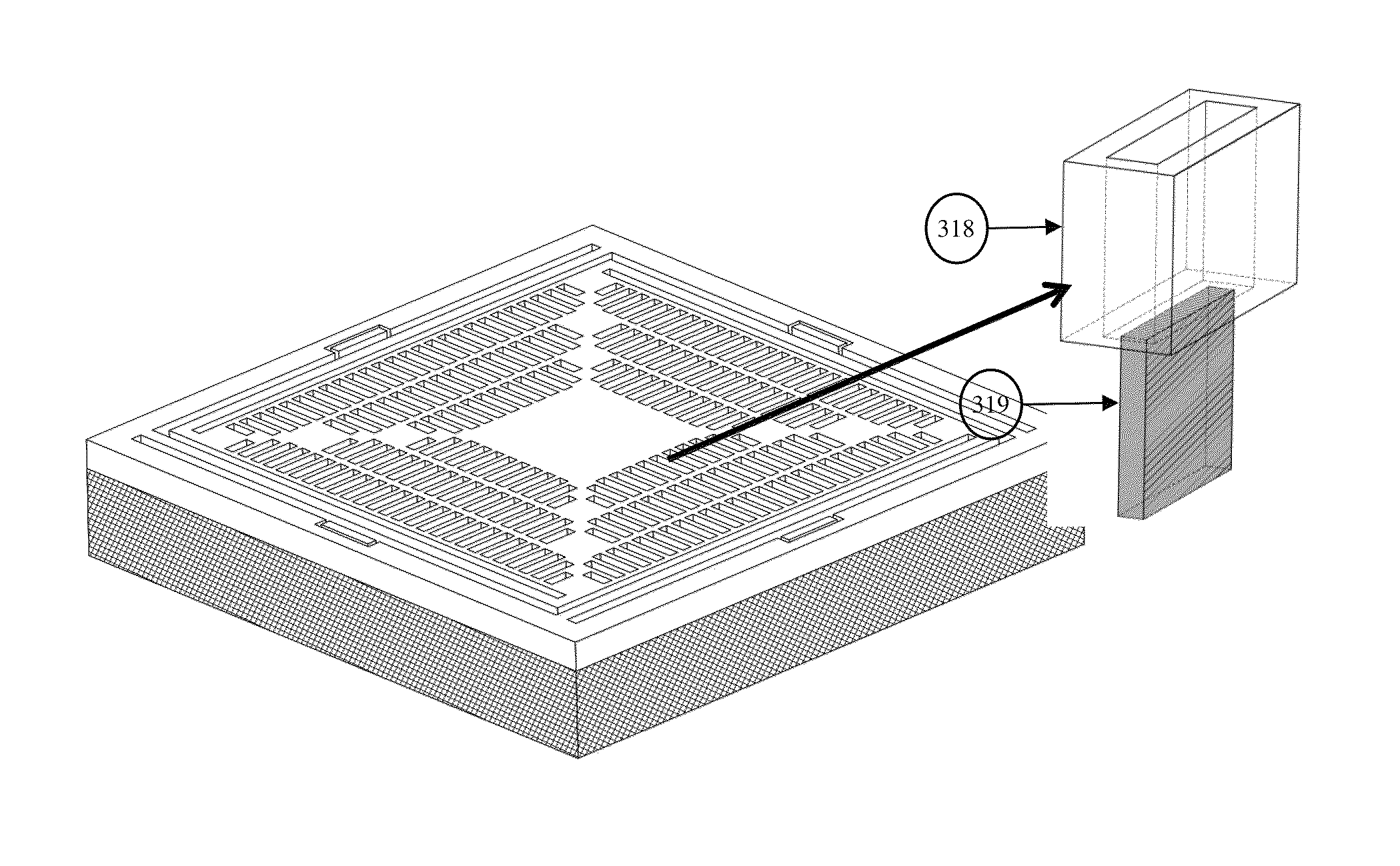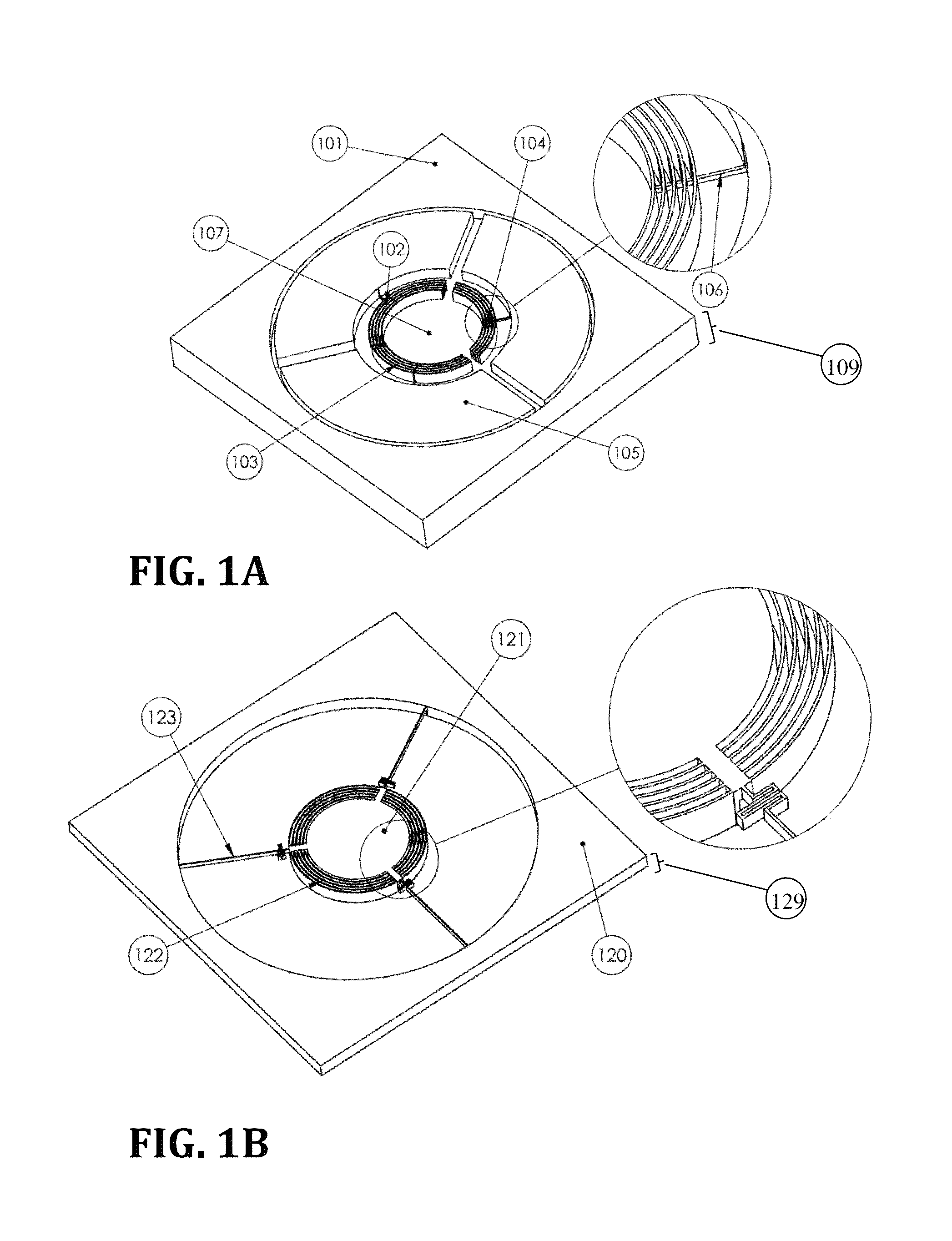Piston-tube electrostatic microactuator
a microactuator and pipe-tube technology, applied in the field of microactuators, can solve the problems of high power consumption and large size, difficult fabrication, sensitive to temperature, etc., and achieve the effect of reducing the gas damping
- Summary
- Abstract
- Description
- Claims
- Application Information
AI Technical Summary
Benefits of technology
Problems solved by technology
Method used
Image
Examples
embodiment 1
[0046]A first embodiment of the present invention (3-DOF MEMS electrostatic actuator) is illustrated in FIG. 1. The actuator comprises of a fixed structure, as illustrated in FIG. 1A, that comprises of a plurality of co-centric arc-shaped pistons 102, 103, 104, fabricated in the thickness 109 of a Si wafer 101. The actuator further comprises of a moving structure that comprises of a plurality of co-centric arc-shaped open tubes 122 (FIG. 1B). The tubes are sized and designed to receive the pistons of the fixed structure.[0047]The arc-shaped pistons are divided into three groups 102, 103, 104 that are arranged at 120°. Each group forms one stator of the actuator The pistons are vertically aligned with the arc-shaped open tubes 122 in the rotor. During the actuation, the pistons enter into the tubes and they inter-digitate during the actuation. The three stators 102, 103, 104 are electrically isolated from one another by utilizing the Buried Oxide (BOX) layer 107 of the SOI wafer. How...
embodiment 2
[0051]Another embodiment of the present actuator is illustrated in FIG. 2. In this embodiment the piston and tubes are aligned radially. The electrodes of the stator 201 and the rotor 225 are arranged in such a way that reduces changes in the gap 126 during rotation. The pistons 204, 205, 206, 207 in this embodiment are fabricated in a Si wafer 201, as plurality of pistons extending vertically upward from the bottom surface of the Si wafer 202, illustrated in FIG. 2A, extend radially from the inside to the outside periphery of the actuator. In this embodiment, the pistons are divided into four groups 204, 205, 206, 207, each being a stator. Similarly, the open tubes are fabricated in another Si wafer 225, as illustrated in FIG. 2B. The open tubes are also fabricated in four different groups 226, 227, 228, 229, that make the rotor of the actuator. The tubes are fabricated in the thickness of the wafer 225 around an actuator plate 222. The rotors are connected to the outer edges of th...
embodiment 3
[0052]Another embodiment of the actuator is illustrated in FIG. 3. The subarray of pistons 304, 305, 306, 307 in this embodiment have rectangular cross-sections, and they are etched inside the base plate 301. This plate is fixed and it is therefore the stator of the actuator. A supporting frame 302 is kept around the pistons to later attach the rotor plate to. The base plate has a thickness 309A and the pistons have a length (height) 309B. Pistons extend vertically upward from the bottom of the base plate where the insulating layer 303 is located. The piston length 309B is smaller than the thickness of the plate 309A. In this embodiment, the pistons are made in four groups, each group comprising of three rows of pistons, extending horizontally along the two in-plane x and y axes The pistons in each stator are electrically connected to each layer through a small thickness layer 308. The pistons in each subarray are electrically insulated from other subarrays. It would be readily appa...
PUM
 Login to View More
Login to View More Abstract
Description
Claims
Application Information
 Login to View More
Login to View More - R&D
- Intellectual Property
- Life Sciences
- Materials
- Tech Scout
- Unparalleled Data Quality
- Higher Quality Content
- 60% Fewer Hallucinations
Browse by: Latest US Patents, China's latest patents, Technical Efficacy Thesaurus, Application Domain, Technology Topic, Popular Technical Reports.
© 2025 PatSnap. All rights reserved.Legal|Privacy policy|Modern Slavery Act Transparency Statement|Sitemap|About US| Contact US: help@patsnap.com



